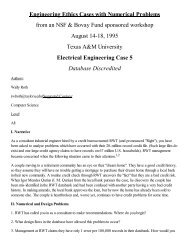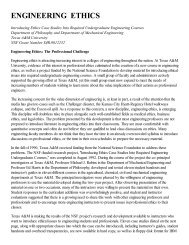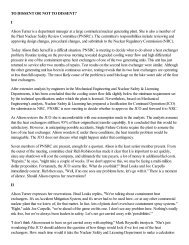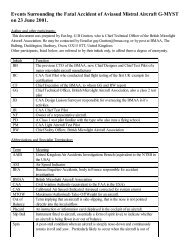The Aberdeen Three Case - Engineering Ethics - Texas A&M ...
The Aberdeen Three Case - Engineering Ethics - Texas A&M ...
The Aberdeen Three Case - Engineering Ethics - Texas A&M ...
Create successful ePaper yourself
Turn your PDF publications into a flip-book with our unique Google optimized e-Paper software.
ENGINEERING ETHICS<br />
<strong>The</strong> <strong>Aberdeen</strong> <strong>Three</strong><br />
Department of Philosophy and Department of Mechanical <strong>Engineering</strong><br />
<strong>Texas</strong> A&M University<br />
NSF Grant Number DIR-9012252<br />
Introduction To <strong>The</strong> <strong>Case</strong><br />
<strong>The</strong> <strong>Aberdeen</strong> Proving Ground in Maryland is a U.S. Army facility where, among other things, chemical<br />
weapons were developed. <strong>The</strong> "<strong>Aberdeen</strong> <strong>Three</strong>" <strong>Case</strong> involved three high-level civilian managers at the<br />
<strong>Aberdeen</strong> Proving Ground in Maryland. All three managers were chemical engineers in charge of the<br />
development of chemical weapons. In 1989, the three engineers were indicted for a criminal felony, tried and<br />
convicted of illegally handling, storing, and disposing of hazardous wastes in violation of the Resource<br />
Conservation and Recovery Act (RCRA). <strong>The</strong> violations occurred between 1983 and 1986.<br />
Instructor Guidelines<br />
<strong>The</strong> issues covered in the student handout include the importance of an engineer's responsibility to public welfare,<br />
and the need for this responsibility to hold precedence over any other responsibilities the engineer might have.<br />
Also discussed are the responsibilities of a manager/engineer to look after the safety and well being of his/her<br />
subordinates. A final point is the fact that no matter how far removed an engineer may feel from society and the<br />
environment, all of our actions have an impact and are subject to the same guidelines that affect others in our<br />
field. This point is especially important in this case because of the criminal violations of the Resource<br />
Conservation and Recovery Act.<br />
A videotape presentation of the case by Jane Barrett, the prosecuting attorney, is available from<br />
Geo-Centers, Inc.<br />
1220 12th SE, #300<br />
Washington, DC 2003-3723<br />
Phone 202-544-7277<br />
A suggested method of presenting this case to the class involves giving the students the handout a day or two<br />
before showing the videotape. After showing the videotape, the next class period could be spent discussing the<br />
case, using the enclosed overheads to review the roles of the people involved, the key dates, and the key issues.<br />
Listed below are some sample questions to stimulate class discussion<br />
Questions for Class Discussion<br />
1) What could the three engineers have done differently?<br />
2) What, if anything, could their subordinates have done differently?<br />
3) What, if anything, could their superiors (i.e., the Army command) have done differently?<br />
4) Should the Justice department have done anything differently?<br />
5) Do you think the judge's sentencing of the "<strong>Aberdeen</strong> <strong>Three</strong>" was too lenient or too harsh? Why?<br />
6) What do you (the students) see as your future engineering professional responsibilities in relation to preserving<br />
or protecting the environment?
Essay #7, "Engineers and the Environment," appended at the end of the case listings will be found directly<br />
pertinent in preparing to discuss these issues. Also, essays #1 through #4 will have relevant background<br />
information for the instructor preparing to lead classroom discussions. <strong>The</strong>ir titles are, respectively: "<strong>Ethics</strong> and<br />
Professionalism in <strong>Engineering</strong>: Why the Interest in <strong>Engineering</strong> <strong>Ethics</strong>?;" "Basic Concepts and Methods in<br />
<strong>Ethics</strong>;" "Moral Concepts and <strong>The</strong>ories;" and "<strong>Engineering</strong> Design: Literature on Social Responsibilities Versus<br />
Legal Liability."<br />
Recommended Overheads<br />
1) Organizations/People Involved<br />
2) Key Dates<br />
3) Key Issues<br />
<strong>The</strong> <strong>Aberdeen</strong> <strong>Three</strong> Overheads<br />
1) Organizations/People Involved<br />
2) Key Dates<br />
3) Key Issues<br />
ORGANIZATIONS/PEOPLE INVOLVED<br />
ABERDEEN PROVING GROUND - U.S. Army facility, which employed the following three civilians:<br />
CARL GEPP - Manager at the Pilot plant. He answered to Dee and Lentz.<br />
WILLIAM DEE - Developed the binary chemical weapon. He headed the chemical weapons development<br />
team.<br />
ROBERT LENTZ - In charge of developing the processes that would be used to manufacture chemical<br />
weapons.<br />
U.S. JUSTICE DEPARTMENT<br />
JANE BARRETT - Prosecuting attorney<br />
KEY DATES<br />
1976 - Congress passes the Resource Conservation and Recovery Act.<br />
September 17, 1985 - Acid tank leaks into Canal Creek.<br />
March 26, 1986 - Pilot Plant shut down.<br />
June 28, 1988 - Gepp, Dee, and Lentz indicted.<br />
January - February 1989 - Trial of the "<strong>Aberdeen</strong> <strong>Three</strong>"<br />
May 11, 1989 - "<strong>Aberdeen</strong> <strong>Three</strong>" each sentenced to 1000 hours of community service and three years<br />
probation.<br />
KEY ISSUES<br />
HOW DOES THE IMPLIED SOCIAL CONTRACT OF PROFESSIONALS APPLY TO THIS CASE?<br />
WHAT PROFESSIONAL RESPONSIBILITIES DID THE THREE ENGINEERS NEGLECT, IF ANY?<br />
<strong>The</strong> <strong>Aberdeen</strong> <strong>Three</strong> - Environmental Issues<br />
Student Handout - June, 1992
Synopsis<br />
<strong>The</strong> "<strong>Aberdeen</strong> <strong>Three</strong>" <strong>Case</strong> involved three high level civilian managers at the <strong>Aberdeen</strong> Proving Ground in<br />
Maryland. All three managers were chemical engineers in charge of the development of chemical weapons. In<br />
1989, the three engineers were indicted for a criminal felony, tried and convicted of illegally handling, storing, and<br />
disposing of hazardous wastes in violation of the Resource Conservation and Recovery Act (RCRA). <strong>The</strong><br />
violations occurred between 1983 and 1986.<br />
Organizations and People Involved<br />
ABERDEEN PROVING GROUND - U.S. Army facility, which employed the following three civilians:<br />
CARL GEPP - Manager at the Pilot plant. He answered to Dee and Lentz.<br />
WILLIAM DEE - Developed the binary chemical weapon. He headed the chemical weapons development<br />
team.<br />
ROBERT LENTZ - In charge of developing the processes that would be used to manufacture chemical<br />
weapons.<br />
U.S. JUSTICE DEPARTMENT<br />
JANE BARRETT - Prosecuting attorney<br />
Key Dates<br />
1976 - Congress passes the Resource Conservation and Recovery Act.<br />
September 17, 1985 - Acid tank leaks into Canal Creek.<br />
March 26, 1986 - Pilot Plant shut down.<br />
June 28, 1988 - Gepp, Dee, and Lentz indicted.<br />
January - February 1989 - Trial of the "<strong>Aberdeen</strong> <strong>Three</strong>."<br />
May 11, 1989 - "<strong>Aberdeen</strong> <strong>Three</strong>" each sentenced to 1000 hours community service and three years probation.<br />
Details of the <strong>Case</strong><br />
In 1976, Congress passed the Resource Conservation and Recovery Act (RCRA). <strong>The</strong> purpose of the act was<br />
to provide technical and financial assistance for the development of management plans and facilities for the<br />
recovery of energy and other resources from discarded materials and for the safe disposal of discarded<br />
materials, and to regulate the management of hazardous waste.1<br />
This 1976 act expanded the Solid Waste Disposal Act thereby authorizing state program-and-implementation<br />
grants for providing incentives for recovery of resources from solid wastes, resource conservation, and control of<br />
hazardous waste disposal. In addition to establishing the EPA Office of Solid Waste, requiring state planning and<br />
a ban on open dumping of solid hazardous wastes, RCRA also implemented criminal fines for violations of the<br />
open dumping or hazardous waste disposal guidelines.<br />
<strong>Aberdeen</strong> is a U.S. Army facility where, among other things, chemical weapons are developed. All three<br />
engineers involved in the case were experts in the chemical weapons field, and Dee was responsible for<br />
developing the binary chemical weapon. <strong>The</strong> U.S. Army has used the <strong>Aberdeen</strong> Proving Ground to develop,<br />
test, store, and dispose of chemical weapons since World War II. Periodic inspections between 1983 and 1986<br />
revealed serious problems at the facility, known as the Pilot Plant, where these engineers worked. <strong>The</strong>se<br />
problems included
flammable and cancer-causing substances left in the open<br />
chemicals that become lethal if mixed were kept in the same room<br />
drums of toxic substances were leaking. <strong>The</strong>re were chemicals everywhere - misplaced, unlabeled or<br />
poorly contained. When part of the roof collapsed, smashing several chemical drums stored below, no<br />
one cleaned up or moved the spilled substance and broken containers for weeks.2<br />
<strong>The</strong> funds for the cleanup would not have even come out of the engineers' budget. <strong>The</strong> Army would have paid<br />
for the cost of the cleanup. All the managers had to do was make a request for the Army clean-up funds, but<br />
they made no effort to resolve the situation.<br />
When an external sulfuric acid tank leaked 200 gallons of acid into a nearby river, state and federal investigators<br />
arrived and discovered that the chemical retaining dikes were unfit, and the system designed to contain and treat<br />
hazardous chemicals was corroded and leaking chemicals into the ground. <strong>The</strong> three engineers maintained that<br />
they did not believe the plant's storage practices were illegal, and that their job description did not include<br />
responsibility for specific environmental rules. <strong>The</strong>y were chemical engineers, they practiced good "engineering<br />
sense," and had never had an incident. <strong>The</strong>y were just doing things the way they had always been done at the<br />
Pilot Plant.<br />
On June 28, 1988, the three chemical engineers, Carl Gepp, William Dee, and Robert Lentz, now known as the<br />
"<strong>Aberdeen</strong> <strong>Three</strong>," were criminally indicted for storing, treating, and disposing of hazardous wastes in violation of<br />
RCRA at the <strong>Aberdeen</strong> Proving Ground in Maryland after about two years of investigation. Six months following<br />
the indictment, the Federal Government took the case of the "<strong>Aberdeen</strong> <strong>Three</strong>" to court. Each defendant was<br />
charged with four counts of illegally storing and disposing of waste. In 1989, the three chemical engineers were<br />
tried and convicted of illegally storing, treating, and disposing of hazardous waste. William Dee was found guilty<br />
on one count, and Lentz and Gepp were found guilty on three counts each of violating the Resource<br />
Conservation and Recovery Act. Although they were not the ones who were actually performing the illegal acts,<br />
they were the managers and allowed the improper handling of the chemicals. No one above them knew about<br />
the extent of the problems at the Pilot Plant. <strong>The</strong>y each faced up to 15 years in prison and up to $750,000 in<br />
fines, but were sentenced only to three years probation and 1000 hours of community service. <strong>The</strong> judge based<br />
his decision on the high standing of the defendants in the community, and the fact they had already incurred<br />
enormous court costs. Since this was a criminal indictment, the U.S. Army could not assist in their legal defense.<br />
This case marked the first time that individual federal employees were convicted of a criminal act under the<br />
Resource Conservation and Recovery Act.<br />
Discussion of the Ethical Issues<br />
<strong>The</strong> actions of the three engineers bring to mind an important question. <strong>The</strong>se engineers were knowledgeable<br />
about the effects of hazardous chemicals on people and the environment (they developed chemical weapons), so<br />
why were they so seemingly unconcerned about the disposal of hazardous chemicals? It is interesting to note that<br />
even after they were convicted the three engineers showed no apparent remorse for their wrongdoing. <strong>The</strong>y kept<br />
insisting that the whole case was blown out of proportion, and that they had done nothing wrong. All containers<br />
of hazardous chemical have labels which state that the chemicals must be disposed of according to RCRA<br />
requirements, yet the three engineers maintained that they had no knowledge of RCRA. Perhaps the best answer<br />
to this question is that they did not hold their responsibilities to the public as engineers as high on their list of<br />
priorities as other responsibilities they held.<br />
To better understand the responsibility of the engineer, some key elements of the professional responsibilities of
an engineer should be examined. This will be done from two perspectives: the implicit social contract between<br />
engineers and society, and the guidance of the codes of ethics of professional societies.<br />
As engineers test designs for ever-increasing speeds, loads, capacities and the like, they must always be aware<br />
of their obligation to society to protect the public welfare. After all, the public has provided engineers, through<br />
the tax base, the means for obtaining an education and, through legislation, the means to license and regulate<br />
themselves. In return, engineers have a responsibility to protect the safety and well-being of the public in all of<br />
their professional efforts. This is part of the implicit social contract all engineers have agreed to when they<br />
accepted admission to an engineering college. According to the prosecution, the three engineers involved in the<br />
<strong>Aberdeen</strong> case placed a low priority on this responsibility to society, and instead emphasized the importance of<br />
their military mission.3 <strong>The</strong> first canon in the ASME Code of <strong>Ethics</strong> urges engineers to "hold paramount the<br />
safety, health and welfare of the public in the performance of their professional duties." Every major engineering<br />
code of ethics reminds engineers of the importance of their responsibility to keep the safety and well being of the<br />
public at the top of their list of priorities. Although company loyalty is important, it can, in some circumstances be<br />
damaging to the company, if the employee does not think about the long-term effects of his actions on the<br />
company.<br />
It is a sad fact about loyalty that it invites...single-mindedness. Single-minded pursuit of a goal is sometimes<br />
delightfully romantic, even a real inspiration. But it is hardly something to advocate to engineers, whose impact on<br />
the safety of the public is so very significant. Irresponsibility, whether caused by selfishness or by magnificently<br />
unselfish loyalty, can have most unfortunate consequences.4<br />
<strong>The</strong> engineers were also unaware that their experiments and their handling of waste products had social impact,<br />
even though they considered themselves to be far removed from the outside world. <strong>The</strong> leaking of sulfuric acid<br />
into Canal Creek quickly disproved their claim of being removed from the outside world. No matter how far an<br />
engineer feels removed from society, he still has an effect on it, even if it is an indirect one. Even though the Pilot<br />
Plant was located on a military base, it still had to follow the RCRA guidelines, regardless of its military mission.<br />
In addition to their responsibilities to society in general, the "<strong>Aberdeen</strong> <strong>Three</strong>" also had responsibilities to their<br />
subordinates, which they also overlooked. It was one of these employees who originally went to the press and<br />
exposed what was going on at the Pilot Plant. Employees were working under conditions where chemicals were<br />
dripping down from leaky pipes above them, and in violation of RCRA rules. Employees who had no hazardous<br />
materials training were ordered to handle and dispose of chemicals about which they had little or no knowledge.<br />
Whether or not there were rules for the training of employees who would be handing hazardous materials, the<br />
three engineers had a responsibility to those employees to inform them of what they were dealing with and how<br />
to handle the waste materials properly.<br />
<strong>The</strong> three engineers convicted in this case were well aware of the dangers the chemicals they worked with on a<br />
daily basis posed to society, yet they allowed their unfounded feelings of separation from the outside world and<br />
their misguided loyalty to their military mission to lessen the importance they placed on their responsibility to<br />
society as engineers. <strong>The</strong> prosecutor in the case had this to say about the <strong>Aberdeen</strong> <strong>Three</strong>: "<strong>The</strong>se are experts in<br />
their field. If they can't be expected to enforce the law, then I'm not sure who can."5<br />
Annotated Bibliography<br />
Curd, Martin and May, Larry, "Professional Responsibility for Harmful Actions," Module Series in Applied<br />
<strong>Ethics</strong>, Center for the Studies of <strong>Ethics</strong> in the Professions, Illinois Institute of Technology, 1984.
This essay explores the grounds on which professionals should be held responsible for harms caused by their<br />
actions. Most examples used concern engineers, designers, and architects involved in real-life cases from tort<br />
law.<br />
Davis, Michael, "Thinking Like An Engineer: <strong>The</strong> Place of a Code of <strong>Ethics</strong> in the Practice of a Profession,"<br />
Philosophy & Public Affairs, Vol. 20, No. 2, Spring 1991, pp. 150-167. (see also, "Explaining Wrongdoing,"<br />
Journal of Social Philosophy, Vol. 20, Numbers 1&2, Spring/Fall 1989, pp. 74-90.<br />
In these lucid essays, Davis argues that "a code of professional ethics is central to advising individual engineers<br />
how to conduct themselves, to judging their conduct, and ultimately to understanding engineering as a<br />
profession." Using the now infamous Challenger disaster as his model, Davis discusses both the evolution of<br />
engineering ethics as well as why engineers should obey their professional codes of ethics, from both a pragmatic<br />
and ethically-responsible point of view. Essential reading for any graduating engineering student.<br />
Nesteruk, Jeffrey, "<strong>The</strong> Ethical Significance of Corporate Law," Journal of Business <strong>Ethics</strong>, Vol. 10, No. 9,<br />
September 1991, pp. 723-727.<br />
In this article, the focus is corporate decision-making structures, and conflicts regarding particular role<br />
obligations. Nesteruk argues that as laws change, so do the roles in the corporate hierarchy, thereby creating<br />
problems in the legal scholarship of corporate social responsibility.<br />
Robinson, Carlton C., "Safety--An Important Responsibility," ITE Journal (Institute of Transportation<br />
Engineers), Vol. 61, No. 7, July 1991, pp. 21-24.<br />
This article discusses safety as a critical ingredient for transport engineers and their managers.<br />
Schapker, Dennis R., "Tort Reform and Design Professionals," Journal of Professional Issues in<br />
<strong>Engineering</strong>, Vol. 116, July 1990, pp. 258-265.<br />
Discusses the battle over tort reform and how it has affected the engineering profession since 1980. It is a call for<br />
engineers to get involved in the debate.<br />
Stone, Christopher D., "Where the Law Ends: <strong>The</strong> Social Control of Corporate Behavior," New York:<br />
Harper & Row, 1975.<br />
This book looks at corporate moral behavior; in particular, how law is a reaction to misdeeds in business<br />
behavior. Stone provides a thorough, albeit negative analysis of corporate ethics, and provides recommendations<br />
for promoting ethical behavior. Although written in 1975, the book still holds value for the student interested in<br />
social responsibility versus legal liability issues.<br />
Tomlinson, Don E., "Choosing Social Responsibility Over Law: <strong>The</strong> Soldier of Fortune Classified Advertising<br />
<strong>Case</strong>s," Business and Professional <strong>Ethics</strong>, Vol. 9, Nos. 1&2, Spring-Summer 1990, pp. 79-96.<br />
This article discusses the ethics of the Soldier of Fortune's guns-for-hire advertisements that resulted in several<br />
murders across the United States.<br />
Notes
1 Resource Conservation and Recovery Act of 1976. P.L. 94-580. Abstract.<br />
Lengthy congressional document which outlines the planning and implementation of stricter guidelines for the<br />
handling, treatment, storage and disposal of environmentally hazardous materials. Challenging to read.<br />
2 Weisskoph, Steven. <strong>The</strong> Washington Post Magazine. "<strong>The</strong> <strong>Aberdeen</strong> Mess" January 15, 1989. p. 55.<br />
Article that went to print just as the case was going to trial. Focuses on the personal side of the case, and comes<br />
across as being biased in favor of the defendants. 8 pages.<br />
3 Videotape of prosecuting attorney Jane Barrett.<br />
4 Baron, Marcia. <strong>The</strong> Moral Status of Loyalty. Illinois Institute of Technology: Center for the Study of <strong>Ethics</strong> in<br />
the Professions, 1984, p. 9.<br />
One of a series of monographs on applied ethics that deal specifically with the engineering profession. Provides<br />
stimulating discussions both for and against loyalty. 28 pages with notes and an annotated bibliography.<br />
5 Weisskoph, p. 57.













